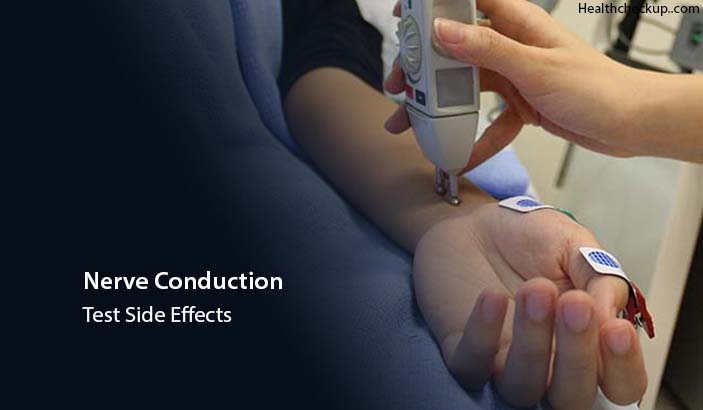The nerves in our body are a vital component of the intricate communication network that communicates signals and responses between the brain and the different organs. Therefore the functioning of our organs is linked to the nerves that make up the nervous system. If the nerves are not conducting stimuli or signals properly, there is every chance that the concerned muscle or body part malfunctions. Thus it becomes crucial for doctors to evaluate a particular nerve or set of nerves on the ability to transmit or conduct signals.
The process of measuring the responses derived by electrical activation of nerves and measuring their efficiency is called nerve conduction study. Small, clinically safe electrical pulses are used as activator, and the responses of the nerves to these stimuli are measured. The results aid doctors to gauge the health condition of the nerve, the associated muscle as also the neuromuscular junction. However, many people worry about the nerve conduction test side effects. More about that later.
Nerve conduction tests are extremely useful to diagnose a variety of nerve-related disorders such as myasthenia gravis, which adversely affects nerve-muscle communication. Similarly, nerve conduction test results interpretation can be used for confirming plexus conditions in the limbs, trapped nerve- the personal nerve in the knee region, ulnar nerve in the elbow area, or the carpal tunnel in the wrist. The test is useful to study nerve roots located in the neck and those in the lower back region too.
Nerve conduction tests are generally applied to patients suffering health problems associated with nerve function or that of the muscles. Common symptoms of nerve-related problems include tingling sensation, numbness, pains or weakness. It is also useful for nerve pain treatment without medication. In many cases, even though the patient might be suffering nerve-related problems, the results of the physical tests can turn out normal. It is in such cases that a nerve conduction test can prove very useful.
The Nerve Conduction Test is useful in evaluating the efficiency of both the major nerve categories – motor as well as sensory. While the motor nerves convey brain signals to the muscles, to make them contract and move, the sensory nerves are meant for transmitting signals to the brain. When a motor nerve is stimulated by passing electric signals through the metallic electrodes attached to the skin, the nerves lying on the muscle, respond. This response is immediately recorded for evaluation. Similarly, with the help of stimulation passed through metallic electrodes, the response emitted by sensory nerves covering the concerned nerve can be measured. The magnitude of the nerve impulse, to the electric pulse, provides vital information pertaining to a number of nerve fibers that are present in the nerve. The test also gives us information about the condition of the insulating membrane -myelin- surrounding the nerve cable.
You don’t need to worry unduly about nerve conduction test pain as it is basically safe and a non-invasive procedure. After you’re properly positioned, the skin area, where the electrodes are attached, is prepared. Once this is done, electrodes are attached and the stage is set for applying electrical pulses to stimulate the nerves. The electric pulses are low-intensity and therefore safe for you. To avoid excessive noise or interferences in the recording quality, it’s important that you remain calm and relaxed to the extent possible.
After the nerve conduction tests are completed, you are free to leave. Here on, it is the turn of the technician to compile the readings and prepare a report. Your doctor will study the report and give you an evaluation of the situation.
Nerve Conduction Test Side-Effects
As discussed, the nerve conduction is a safe procedure and side-effects are virtually non-existent or rare, as it is a non-invasive procedure. Apart from possible discomfort at the site where electrodes are attached to the skin, you will not experience any kind of side-effects. In case you’re using a pacemaker, the technician will avoid stimulating areas near the torso.
The possible risks you may encounter are bleeding or infection caused by insertion of the needle. Your doctor will advise you on the necessary steps to avoid these risks/ side effects.
How To Prevent Nerve Conduction Test Side-Effects
Before you take the NCT, your neurologist will advise you on the preparations and required precautions you need to observe. Do not apply skin creams or any kinds of emollients on your limbs as the hands and feet are usually the spots chosen for conducting nerve tests. Best to avoid creams after you take the last shower prior to the nerve conduction test. Also intimate the technician performing the test, if you’re on a heart pacemaker or using blood-thinning medications.
There are a few factors that influence the results of a nerve conduction test. While the health condition of the particular nerve is the biggest factor in the outcome of the test, other variables include the age of the patient, skin temperature and the presence or absence of swelling in the test area.
The nerve conduction test is an invaluable aid to the physical examinations that are usually associated with the investigation of health issues related to nerves. The test can confirm the presence or absence of certain nerve conditions. Without worrying about nerve conduction test side effects, you can take the test as it can help allay undue fears and suspicions associated with nerve-related illness.
Medically Reviewed By










